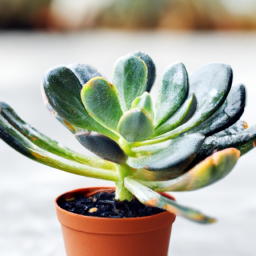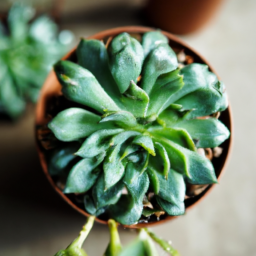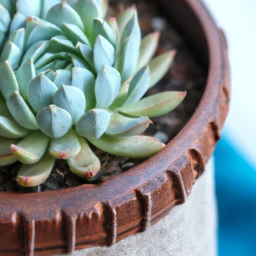
Are you looking to add some greenery to your indoor space but don’t have a green thumb? Look no further! In this blog post, we will be discussing the best indoor succulents that are perfect for beginners and seasoned plant enthusiasts alike. Succulents are known for their low maintenance and unique shapes, making them a popular choice for indoor plants. Whether you’re looking to add some life to your desk, coffee table, or windowsill, these best indoor succulents are sure to brighten up your space. Let’s dive in and explore some of the top options for bringing the beauty of the desert into your home.
Top 10 Best Indoor Succulents for Beginners
Introduction
Indoor succulents are a great way to bring a touch of nature into your home while also adding some greenery to your space. Succulents are known for their low maintenance and unique appearance, making them perfect for beginners who are new to plant care. In this guide, we will explore the top 10 best indoor succulents for beginners, discussing their care requirements and unique features.
Aloe Vera
Aloe Vera is a popular indoor succulent known for its medicinal properties and easy care. This plant thrives in bright, indirect light and only needs to be watered sparingly. Aloe Vera is a great addition to any indoor space, as it not only looks beautiful but also has healing properties that can be used for skincare and minor burns.
To care for your Aloe Vera plant, make sure to place it in a sunny spot where it can receive plenty of light. Water your Aloe Vera plant only when the soil is completely dry, as overwatering can lead to root rot. Aloe Vera plants are easy to propagate, making them a great option for beginners looking to expand their succulent collection.
In addition to its medicinal properties, Aloe Vera is also a great air purifier, helping to remove toxins from the air in your home. This plant is a must-have for any indoor gardening enthusiast looking for a low-maintenance succulent with multiple benefits.
Sansevieria
Sansevieria, also known as Snake Plant or Mother-in-Law’s Tongue, is a hardy indoor succulent that is perfect for beginners. This plant is virtually indestructible and can thrive in a variety of lighting conditions, making it a versatile option for any indoor space. Sansevieria is known for its striking appearance, with long, sword-shaped leaves that add a touch of elegance to any room.
To care for your Sansevieria plant, place it in a spot with bright, indirect light and water it sparingly. This plant is drought-tolerant and can go for long periods without water, making it ideal for forgetful gardeners. Sansevieria is also known for its air-purifying properties, helping to remove toxins from the air and improve indoor air quality.
Sansevieria is a low-maintenance succulent that is perfect for beginners looking to add some greenery to their space without a lot of effort. With its striking appearance and easy care requirements, Sansevieria is a top choice for indoor succulent enthusiasts.
Jade Plant
Jade Plant is a popular indoor succulent known for its vibrant green leaves and tree-like appearance. This plant is easy to care for and can thrive in a variety of lighting conditions, making it a great option for beginners. Jade Plant is a symbol of good luck and prosperity, making it a popular choice for indoor gardens.
To care for your Jade Plant, place it in a spot with bright, indirect light and water it sparingly. Allow the soil to dry out between waterings to prevent root rot. Jade Plant is a slow-growing succulent that can live for many years with proper care, making it a great addition to any indoor space.
In addition to its beautiful appearance, Jade Plant is also believed to bring positive energy into your home and attract wealth and prosperity. This plant is a must-have for beginners looking to add a touch of luck to their indoor garden while enjoying its easy care requirements.

How to Care for Indoor Succulents: Tips and Tricks
Choosing the Right Succulent for Your Indoor Space
When it comes to choosing the best indoor succulents, there are a few key factors to consider. First and foremost, you’ll want to think about the amount of sunlight your indoor space receives. Some succulents thrive in bright, direct sunlight, while others prefer indirect light. If your space doesn’t get a lot of natural light, you may want to opt for low-light succulents like Haworthia or Gasteria.
Another important factor to consider is the size of the succulent. Some varieties, like Echeveria and Sempervivum, stay relatively small and compact, making them ideal for small indoor spaces. On the other hand, larger succulents like Aloe and Jade plants can make a bold statement in a larger room.
Lastly, consider the care requirements of the succulent. Some varieties are more forgiving when it comes to watering and soil conditions, while others require more specific care. If you’re new to caring for succulents, you may want to start with a beginner-friendly variety like a Zebra plant or a Snake plant.
Providing the Right Growing Conditions for Your Succulents
Once you’ve chosen the perfect succulent for your indoor space, it’s important to provide the right growing conditions to ensure its health and longevity. Succulents thrive in well-draining soil, so be sure to plant them in a pot with drainage holes to prevent root rot. You can use a cactus or succulent potting mix, or create your own by mixing equal parts potting soil, sand, and perlite.
In terms of watering, succulents prefer to dry out between waterings, so be sure to let the soil dry completely before watering again. Overwatering is one of the most common mistakes people make when caring for succulents, so it’s important to err on the side of underwatering rather than overwatering. In general, you’ll want to water your succulent once every 1-2 weeks, depending on the season and humidity levels.
In terms of light, most succulents prefer bright, indirect sunlight, so be sure to place your succulent near a sunny window. If your space doesn’t get a lot of natural light, you can supplement with a grow light to ensure your succulent gets the light it needs to thrive.
Common Issues and Troubleshooting Tips for Indoor Succulents
Even with the best care, succulents can sometimes run into issues. One common problem is overwatering, which can lead to root rot and other health issues. If you notice your succulent’s leaves turning yellow or mushy, it’s a sign that you may be overwatering. To remedy this, be sure to let the soil dry out completely before watering again.
Another common issue is pests, such as mealybugs or spider mites. If you notice small bugs on your succulent’s leaves or stems, you can try wiping them off with a cotton swab dipped in rubbing alcohol. If the infestation is severe, you may need to treat your succulent with a natural insecticidal soap.
In conclusion, caring for indoor succulents can be a rewarding and enjoyable experience. By choosing the right succulent for your space, providing the right growing conditions, and troubleshooting common issues, you can enjoy beautiful and healthy succulents in your home for years to come.

Creative Ways to Display Indoor Succulents in Your Home
Choosing the Right Succulents
When it comes to choosing the best indoor succulents for your home, there are a few things to consider. First, think about the amount of sunlight your space receives. Some succulents thrive in bright, direct sunlight, while others prefer indirect light. Popular indoor succulents that do well in low light conditions include Haworthia, Gasteria, and Sansevieria.
Another factor to consider is the size of the succulent. If you have limited space, opt for smaller succulents like Echeveria or Sedum. These compact plants are perfect for displaying on windowsills, shelves, or desks. On the other hand, if you have a larger space to work with, consider larger succulents like Aloe Vera or Jade Plant.
Lastly, consider the care requirements of the succulent. Some varieties are more forgiving of neglect, while others require more attention. If you’re new to succulent care, start with easy-to-care-for varieties like Zebra Plant or String of Pearls.
Creative Display Ideas
Now that you’ve chosen the perfect indoor succulents for your space, it’s time to get creative with how you display them. Here are a few ideas to inspire you:
1. Hanging Planters: Hang small succulents in decorative planters from the ceiling or on walls for a unique and eye-catching display. This is a great option for adding greenery to small spaces or for creating a vertical garden.
2. Terrariums: Create your own mini succulent garden in a glass terrarium. Choose a variety of succulents in different shapes, sizes, and colors for a visually appealing display. Terrariums are easy to maintain and can be placed on tables, shelves, or countertops.
3. Succulent Wreaths: Get creative with your succulent display by creating a living wreath. Use a wire wreath frame as a base and fill it with a variety of succulents, moss, and other decorative elements. Hang your succulent wreath on a door or wall for a unique and seasonal display.
4. Succulent Centerpieces: Use succulents as the focal point of your tablescapes by creating succulent centerpieces. Arrange a variety of succulents in a decorative container and add accents like rocks, sand, or driftwood for a natural and stylish look.
5. Vertical Gardens: Create a stunning vertical garden by mounting succulents on a wall or in a frame. This is a great way to add greenery to a room without taking up valuable floor space. Mix and match different succulent varieties for a dynamic and visually interesting display.
Maintenance Tips
Once you’ve set up your indoor succulent displays, it’s important to maintain them properly to ensure they thrive. Here are a few maintenance tips to keep your succulents healthy and happy:
1. Watering: Succulents are drought-tolerant plants, so be sure not to overwater them. Allow the soil to dry out completely between waterings, and water sparingly during the winter months when growth slows down.
2. Light: Most succulents prefer bright, indirect light. Place your succulents near a window where they can receive plenty of sunlight throughout the day. Rotate your succulents occasionally to ensure they receive even light exposure.
3. Soil: Use a well-draining potting mix specifically designed for succulents to prevent root rot. Avoid using regular potting soil, as it retains too much moisture for succulents.
By following these creative display ideas and maintenance tips, you can enjoy beautiful indoor succulents in your home for years to come. Experiment with different arrangements and styles to find the perfect display that suits your space and personal style. Remember to have fun and get creative with your indoor succulent displays!
Crisp Recap
Succulents are a popular choice for indoor plants due to their low maintenance and unique appearance. When it comes to choosing the best indoor succulents, there are a few varieties that stand out for their ability to thrive in indoor environments. One top choice is the Echeveria, known for its rosette-shaped leaves and vibrant colors. These plants are easy to care for and can add a pop of color to any indoor space.
Another great option for indoor succulents is the Aloe Vera plant. Not only is it aesthetically pleasing with its spiky leaves, but it also has healing properties that make it a valuable addition to any home. Aloe Vera plants are known for their air-purifying qualities and can thrive in a variety of indoor conditions. Overall, when it comes to choosing the best indoor succulents, it’s important to consider factors such as light levels, watering needs, and space requirements to ensure that your plants will flourish in their new environment.
Here are this week’s Top Questions and Answers
Q1. What are some of the best indoor succulents for beginners?
A1. Some of the best indoor succulents for beginners include the Aloe Vera, Echeveria, and Haworthia. These plants are easy to care for and can thrive in indoor environments with proper sunlight and watering.
Q2. How often should I water indoor succulents?
A2. Indoor succulents should be watered sparingly, allowing the soil to dry out completely between waterings. Depending on the succulent variety and the environment, this could range from every 1-2 weeks to once a month.
Q3. What kind of light do indoor succulents need?
A3. Indoor succulents thrive in bright, indirect light. Place them near a window where they can receive sunlight for a few hours a day. Avoid placing them in direct sunlight for extended periods as this can cause sunburn.
Q4. How do I prevent my indoor succulents from becoming leggy?
A4. To prevent indoor succulents from becoming leggy, make sure they are receiving enough sunlight. Rotate the plant occasionally to ensure even growth on all sides. If the succulent starts to stretch out, consider moving it to a sunnier spot.
Q5. Can indoor succulents be grown in containers without drainage holes?
A5. While it is possible to grow indoor succulents in containers without drainage holes, it is not recommended. Without proper drainage, excess water can accumulate at the bottom of the pot and lead to root rot. It’s best to use containers with drainage holes to ensure the health of your succulents.
Dr. Olivia Green is a botanist with over two decades of experience in indoor plant cultivation. She holds a Ph.D. in Plant Biology and has dedicated her career to researching plant behavior in controlled environments. Dr. Green is passionate about helping plant enthusiasts master the art of indoor gardening through her extensive knowledge and practical insights.


